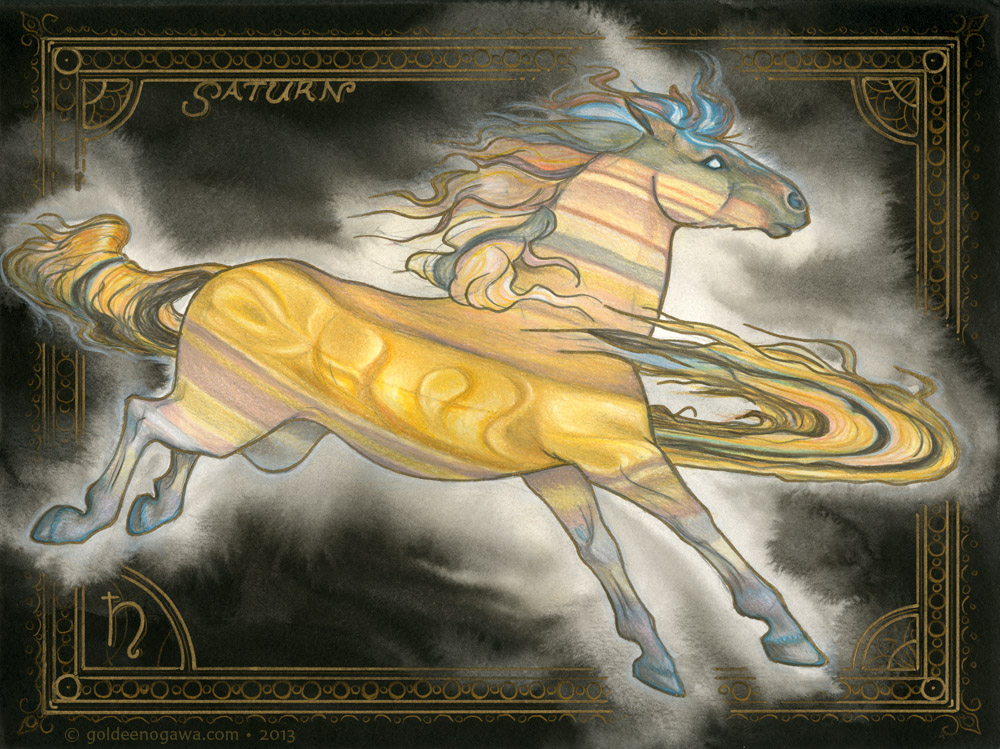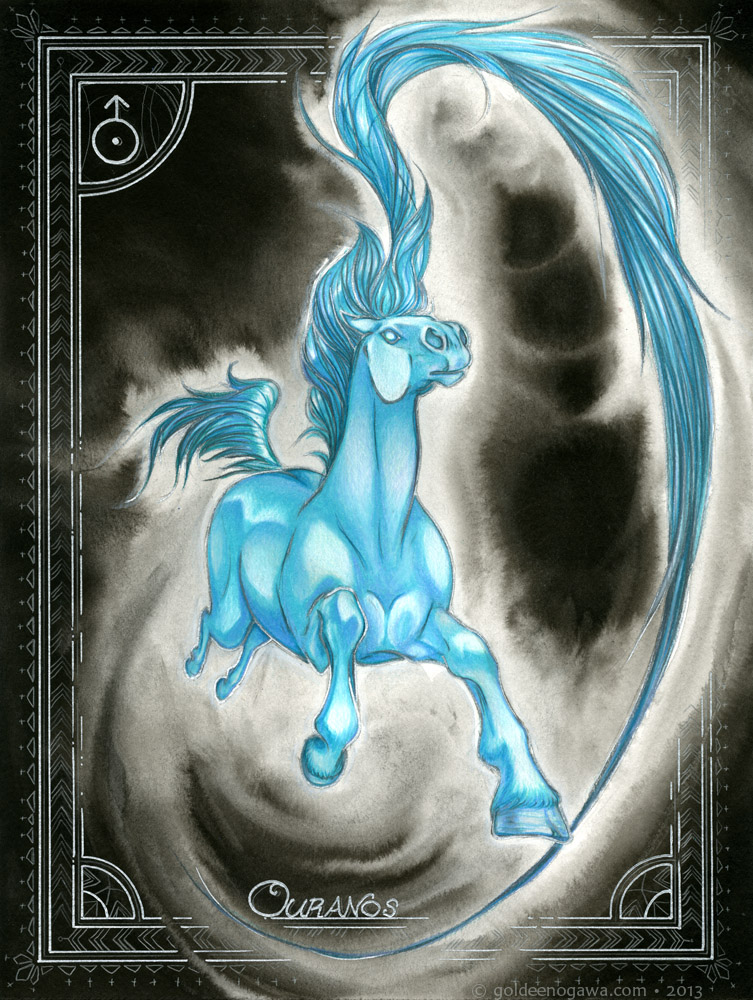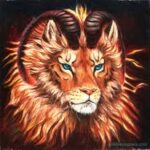These four paintings were done in October and November of 2013 for an art show at Midwest FurFest (where they all sold, happily). I had wanted to try doing horses as representations of the planets, and began with Jupiter as an experiment. That turned out so well I went on and did the other three Gas Giants. Whether I continue and do the inner four planets, the Galilean Moons, Titan, and how I will handle Pluto, is still up in the air. Considering what a positive response I got for the four giants, however, it is something I’m keeping very much in mind.
All these pictures were made on 9″x12″ bristol board using black ink, some watercolor, colored pencils, gold or silver paint pen, and metallic colored pencils. For the art show they were matted with custom painted mats to match the background, with metallic detailing on the bevel. They are all available as prints of all sizes from my print shop. Click the image to see a larger version.
The Shire draft horse represents Jupiter, first and largest of the gas giants, and the largest planet in our solar system. It is named for the king of the Roman gods, the god of sky and thunder: the Roman personification of the Greek Olympian god Zeus. The astronomical symbol for the planet Jupiter rests in the upper-left corner, while the wave pattern border echoes the swirling colored bands of storm systems that encircle the planet
Not pictured: the Shetland Pony moons, Io, Europa, Ganymede and Callisto.
Available as a print here.
Jupiter was the first Planet Horse I started, and when I did I was uncertain as to whether it would even turn out all right. Once I’d finished his head, however, I realized I would have to do at least the four gas giants. I chose the Shire horse to represent Jupiter, since it as arguably the largest breed of horse in the world today.
The Andalusian, or Pure Spanish Horse, represents Saturn, the second-largest planet in our solar system renowned for its impressive rings. It is named for the Roman god of generation, liberty and renewal, the Roman personification of the Greek god Cronos, father of Zeus, who ruled over the Golden Age of Rome. The astronomical symbol for Saturn can be found in the lower left-hand corner, while the border contains a repeating circle motif, reminiscent of the planet’s famous ring system.
Available as a print here.
For Saturn I had a lot of fun figuring our how I would represent that planet’s famous ring system. It was fun working the colors of the tail into something similar to the bands of light and dark in Saturn’s rings. The blue streaks in the forelock and down the forehead were inspired by pictures of Saturn’s polar auroras. An additional honor: this piece won a Staff Pick and the Director’s Choice Award at MFF. They gave me a plaque and everything. I was utterly surprised and delighted.
The Lippizaner represents Ouranos, third of the gas giants and first of the ice giants. Named for the the primordial Greek god of the sky and heavens, its name is sometimes Latinized as Uranus. Ouranos was the father of Cronus (Saturn) and the grandfather of Zeus (Jupiter). The symbol for Ouranos can be found in the upper-left corner, while the angular chevron and triangular patterns represent the water, ammonia and methane crystals prevalent in its upper atmosphere.
Available as a print here.
First I suppose I should explain: Ouranos is the Greek spelling of Uranus, which in turn is the name for the primordial Greek god of the heavens. I chose to use the Greek spelling because it does not, when said out loud (“Ow-ra-nos”), prompt people to make bad jokes about its similarity to a certain part of a person’s anatomy. I have gotten quick sick of it, so I went with the original spelling. I chose the Lippizaner to represent Ouranos, and placed it in a portrait rotation (unlike the other three) as a reference to the planet’s heavily tilted axis. As with Saturn, I had fun using the mane to represent the rings.
The Friesian horse represents Neptune, the fourth and final gas giant, and the only other ice giant apart from Ouranos. It is named for the Roman god of the seas (who was also, it should be noted, the god of horses and horse racing), the brother of Jupiter and the Roman personification of the Greek god Poseidon. The astronomical symbol for Neptune rests in the upper-left corner, while the filigree and droplet patterns evoke both the content of the oceans, as well as the breakers and seashells.
Available as a print here.
Finally, there is Neptune. I finished this one on Monday, November 18th, just a day before I had to leave for Chicago. I’m glad I did though: I feel they looked far better as a complete set. Neptune is also my personal favorite from the bunch, and I had considered keeping the original if it did not sell. It did, of course, but I cannot bring myself to be upset by that.
*
Goldeen Ogawa is a writer, illustrator and cartoonist. To keep tabs on what she is doing you can follow her on twitter @GrimbyTweets. You can also send her an email at goldeenogawa@gmail.com.






























